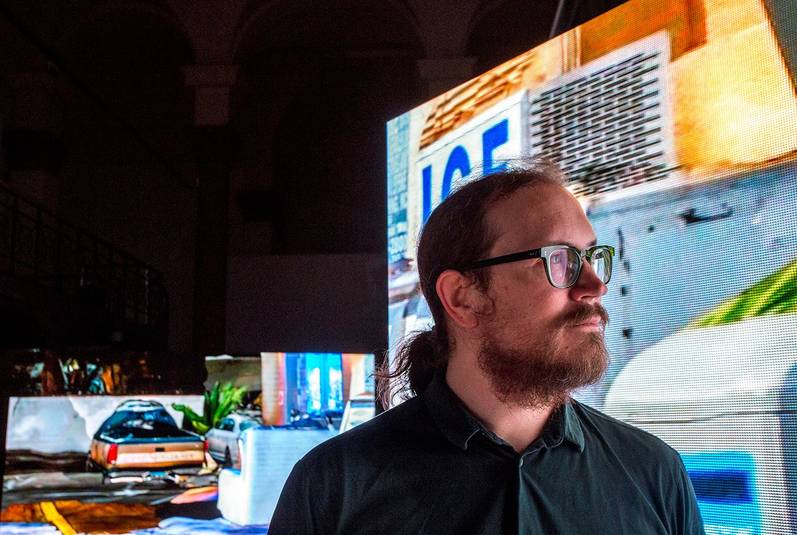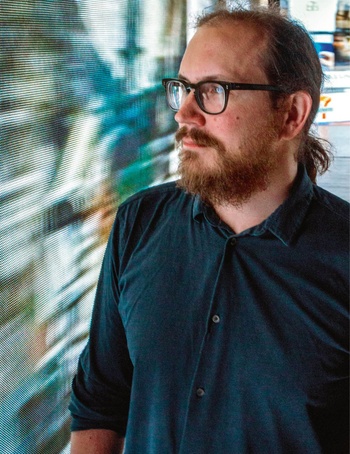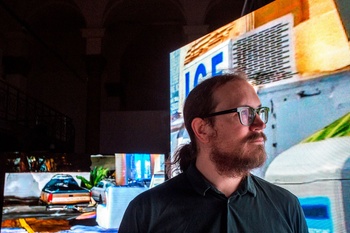The sensation of the autumn exhibition season will undoubtedly be Emmanuel Van der Auwera. With solo shows at the Botanique and at Harlan Levey Projects, as well as spot in the group exhibition at Wiels later this month, there is no escaping the intriguing cinematic mirror he holds up to us, obsessive appers.
© Emmanuel Van der Auwera

Emmanuel Van der Auwera
- Is born in Brussels in 1982
- Moves around between Charleroi (where he spends his childhood), Switzerland, and France
- Studies at the École supérieure d’Art in Clermont-Ferrand (2005-2008) and the Studio national des arts contemporains Le Fresnoy in Tourcoing (2008-2010)
- Moves back to Brussels, where he still works and lives • Wins the Prix Médiatine 2012
- Studies at the Higher Institute for Fine Arts (HISK) in Ghent between 2013 and 2015
- Is selected for the Young Belgian Art Prize 2015 and receives the Langui Award
- Finds a home at Harlan Levey Projects where he has his first solo show “Everything Now Is Measured by After” in 2017
- Is invited to show his work at Wiels, Mu.ZEE, Centre Pompidou, KANAL, Palais de Tokyo, Art Brussels...
- Has his first solo show in the US, at Dallas’s 214 Projects
People have this idea that the world is going to be destroyed, that everything is going to be lost. It’s not. This is the digital age and it will still be the digital age. Nothing is being lost, it’s all still gonna be here. We are temporary, our bodies are temporary, but what we do is permanent.”
A prophet seems to inhabit the museum of the Botanique. His words resound in the empty hall, while three screens each measuring roughly four metres by two and a half metres transect the space and throw images of a desolate, frozen urban landscape into the world. The difference between the universe that you explore with your eyes and the one where you have planted your feet is both patently clear and constrictively small.
The Sky Is on Fire is one part of a diptych that will catapult Emmanuel Van der Auwera to be the sensation of the autumn exhibition season – there, a prophecy of our own! Part two, The Death of K-9 Cigo, will run parallel at Harlan Levey Projects. With his place in the group show “Open Skies” at Wiels later this month, Emmanuel Van der Auwera will be more or less everywhere in Brussels. It was about time. Since he completed a residency at Wiels in 2012 and won the Prix Médiatine in the same year, he has built an impressive career. After winning the 2015 Langui Award of the Young Belgian Art Prize, he found a home at Harlan Levey Projects – one of the most challenging galleries in Brussels – and he then went on to hold exhibitions at Art Brussels, Centre Pompidou, Palais de Tokyo, KANAL, and Mu.ZEE. Recently, 214 Projects in Dallas featured his first solo in the United States.
And he deserves every moment of it. Through his films, video sculptures, and installations, Emmanuel Van der Auwera creates a fascinating and extremely thoughtful field of tension between art and technology, fiction and reality, event and aftermath. By looking at the production and distribution of images, by deconstructing the process, the fabric, and the materiality through which we perceive, and by making explicit the fact that it is often an affective response in the aftermath of things that shapes the global image that becomes reality, he holds a mirror up to our mind’s eye and impresses upon us the responsibility of our own perspective.
Dog eat dog
The film diptych that he is presenting this autumn is perfectly aligned with that framework. The Sky Is on Fire and The Death of K-9 Cigo are both focused on a tragic event that took place in Miami, though the 2018 Stoneman Douglas High School shooting in Parkland, in which seventeen people were killed, is only mentioned obliquely. To Emmanuel Van der Auwera, the impact of the aftermath is essential. “There is no gun, no violence. People talk about it, but it is left unseen, we’re dancing around the event. I realize there are shootings every week, so it almost feels too close for comfort. But it isn’t about the shootings or about Trump. In thirty years, when he is long gone, the films might be more relevant because they might convey something essential about this time. I hope one day that they will be valuable documents about a moment in time that captured the zeitgeist. The toxicity of it, the despair, the optimism, the speed, the dizzying heights in which we live…” A time and a place that Emmanuel Van der Auwera reconstructs and evokes through images made on his mobile phone. On the one hand by mapping a territory through a Google Maps-like app in The Sky Is on Fire. And on the other by diving into the flood of images on the live video streaming app Periscope and by selecting a whole series of images which together, like artefacts, constitute a splintered witness testimony in The Death of K-9 Cigo.
For The Death of K-9 Cigo, you spent no fewer than fifteen months on Periscope. Did you suffer from withdrawal symptoms?
EMMANUEL VAN DER AUWERA: It became a bit obsessive, yes. (Laughs) But more because I had to find a clear focus for the work. Every hour of every day, there are new videos and testimonies to scout on Periscope. You’re continually strolling around meaninglessness trying to find something meaningful. You have these thousands and thousands of images that are quite poor and dirty, but that at the same time have a certain grace and a raw authenticity.
You have absolutely no control over the material, and that also makes it hard to find focus. But at the same time, I instantly recognized some form of possible editing. One kid was talking about the fact that he had made it, the other one was pointing out all the bouquets on the ground, and another one was in his car talking about his gun. There were even people waiting for Trump’s car to pass by. It really felt like this tiny bubble in which a lot of things were happening that would be able to create meaning together.
We create images that are supposed to come from reality, but we use them to frame reality because it needs to look like the images we created
So what tied it all together?
VAN DER AUWERA: After almost a year, a police dog called K-9 Cigo got shot and killed. The reactions to this event were simply unimaginable. (The scenes of mourning police officers are also part of Van der Auwera’s film, ks) That was the moment that pushed the story and closed the open loop. Together with the Parkland shooting as a starting point, it revealed something broader. About Trump’s America, the performative nature of violence and grief, the state in which people act and witness, and the technology we use to do so.
You don’t strike me as a person who surrenders willingly to the flood on social media.
VAN DER AUWERA: I have almost no presence on social media, actually. I won’t say I’m anti-social media, it’s just not that I ever felt the need for this loophole of sharing and receiving and tagging in my life. I’m probably investigating it because I found it quite shocking to discover that people appeared to be missing these tools so much. I have been witnessing the social media develop and transform into this thing that has reorganized the world. But I remember the world before that, and it didn’t feel that empty.
Like we needed a machine to understand that we needed to interact with other people?
VAN DER AUWERA: And to represent ourselves! There is something incredibly egocentric and ambiguous about it. You need to be authentic and you need to curate everything. That’s an impossible deal. Social media give this appearance of being spontaneous, but they really are just about an immense mass of anonymous superstars who curate the tiniest aspects of their lives. Warhol and his fifteen minutes of fame sound like an archaism in that light. It’s really an economy of emotion. But there was a need, and probably that need comes from our absolute solitude and our narcissistic nature. If you look at the danger of putting any opinion out there, I cannot really fathom how people gather the courage to throw themselves into the pit like that.
And the immediacy of the reactions often struggles with reality that is still forming.
VAN DER AUWERA: More importantly, reality is forming because of that. While it used to be the case that an image was made in order to convey information and digest an event, it now feels like news is really nothing more than opinion. Facts have become irrelevant, since they immediately exist in different framings, also because they are created because of that flood.
It’s like that scientific rule that says that when you observe things you are actually changing them. That goes all the way to quantum physics, where you observe phenomena that exist merely because you’re actually precipitating them. So you need to destroy something in order to see or investigate it. That’s a huge responsibility.

© Heleen Rodiers
What was your responsibility in this work?
VAN DER AUWERA: To engage with a documentary approach. If you approach something with an obvious judgement, that means you want to make a case. You are partisan, basically. You are always partisan, of course. But it’s not my job to tell people what to think about a particular political issue. Because politics and morality are two different things. I think I am trying to engage morally with the work, and to make something that is ethical. So it is my responsibility not to twist the people whose videos I use into a caricature. Take the prophet-like protagonist from The Sky Is on Fire for example. I could have transformed him into a horrible caricature. He has said a lot of things I totally disagree with or find shockingly stupid. But at the same time, to me, there was also meaning in what he was saying, there was depth. In the end, when you go beyond the filters, it is about humans. But in order for him to carry that human value, I needed to rework him. So you can look at him and see that he has a point and that there is beauty in his words, and at the same time you realize he is on the edge of the abyss. But you never feel: poor guy or crazy American.
Sometimes that is difficult.
VAN DER AUWERA: Of course, a lot of people will see the guy at the end of The Death of K-9 Cigo, singing his Trump song, and they will think that he’s slightly ridiculous, but in fact he is not much more problematic than the T-shirts of the progressive left who are jumping on the emotional bandwagon of the tragedy to push their view. There is a real problem with the means to an end. In the end, everyone thinks he has the greater good in mind. The people who believe in the necessity of protecting themselves with guns are not enjoying these tragedies. They just feel the need to be protected. They are not evil per se.
The question nowadays is: do you respect your political adversary or do you think he is an enemy who needs to be destroyed. I think we reached the level where politics is only about that: pointing out people who don’t have the legitimacy to speak. While I believe that everybody has the legitimacy to speak. The white supremacist, the terrorist, they’re usually symptoms of something bigger. But it’s easier to shoot the messenger, especially if the messenger comes in the shape of an extremist idiot who craves destruction.
In the light of the mass of anonymous superstars on social media, Warhol and his fifteen minutes of fame sound like an archaism
Bend it like an apper
It is an appeal to see beyond the end of your own nose. To dig deeper. That is precisely what Emmanuel Van der Auwera does in The Sky Is on Fire, the three-part video at the Botanique. “It started with my interest in the technology that Google Maps uses, the fact that from 2D you burst into some kind of volume. It is a fake 3D effect where artificial intelligence isn’t replicating things like shadows, so it needs a bump into existence. I found that bending of the rules of a 2D image quite interesting in itself. And of course it contains this utopian idea that everything can be captured. Periscope has the same idea behind it: you scout into a map and you enter a world from the satellite perspective. From a bird’s eye view, you can go all the way to the gutter.”
And that’s where you went?
VAN DER AUWERA: Well, I started to wonder: what if we can scout even closer, all the way to being able to pick stuff up and feel the texture of things. And then I found an app that allowed me to reconstruct objects by photographing them from all angles. So I went to Miami and took pictures of the most mundane things, the sad reality of the urban landscape, trash or remnants of everyday life… The thing is, the object you reconstruct is actually a picture that is being bent. The rules of photography are bent like a wormhole, and it creates a kind of volume that has no density.
So The Sky Is on Fire is like the metaphorical representation of the map of Periscope. It’s like taking the logic of Google Maps all the way to its absurd and abstract end. Doing so emphasizes a world frozen in time, a fictionalized space that at the same time synthesizes what is going on in that landscape. But here things are suddenly transformed into ruin. Only, it is not the ruin of time, it’s the ruin of the digital era. Pure surface, no density.

© Heleen Rodiers
Behind this ruin is the recurring story of violence, trauma, and mourning. What do you think they show about humanity?
VAN DER AUWERA: It all comes down to the fact that we feel the necessity to make sense of things that actually have no sense. Events simply occur. But history is just such a series of stories; it is an invention. And I do believe that we need these stories. They will always be part of the human psyche and experience. The necessity of creating myths out of our human experience is not false per se. The problem is that they have started to exist in their own realm, and now they are transforming reality itself. In other words, we create images that are supposed to come from reality, but we use them to frame reality because it needs to look like the images we created. That is what I am addressing with these portraits of people in grief. Whether it happens in Orlando or Russia, it will always create the same images, because we bend reality.
How can art counter that?
VAN DER AUWERA: Well, as an artist you need to be ethically just. You have to find the proper approach. In my view, you can engage with everything, but you have to be aware that you speak from a certain position. I always had a strong connection with The Disasters of War by Goya. He draws the horrors of a war that he never saw personally, but having heard about them, he felt the need to testify about them. So it becomes a documentary thing. It doesn’t report, it is not a reportage, it’s an interpretation through the prism of the artist. And that’s what art does. Art has always been engaged with history and tragedy, but instead of presenting the event and then moving on, there is something essential going on that transcends the specificity of that event. When Goya shows the disasters of war, he is talking about every war. In a way that is similar to what I am doing. There is this humming that reaches all the way to me, and from the humble position which is mine I try to identify things that are symptomatic of the human experience, of tragedy, of how we deal with grief or hide behind symbols. We should show that complexity of the human experience instead of shrinking it and incarnating it into an object that can be grasped, packaged, and marketed. That seems like a cheap way out of a complex issue, and I believe that like a boomerang, it will come back and hit us in the face.
“Whether you like it or not, it’s all still going to be here,” we hear booming through the museum of the Botanique. “This video will be in the Library of Congress. So be careful what you leave behind. You still wanna be a dickhead and blow up the planet?”
> Emmanuel Van der Auwera The Death of K-9 Cigo: > 14/12, Harlan Levey Projects
> The Sky Is on Fire: > 3/11, Botanique
> Open Skies: 27/9 > 5/1, Wiels
Read more about: Expo
Fijn dat je wil reageren. Wie reageert, gaat akkoord met onze huisregels. Hoe reageren via Disqus? Een woordje uitleg.